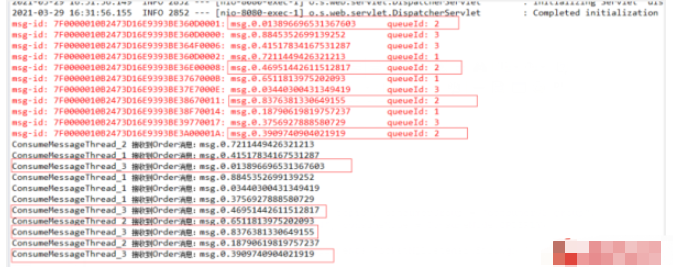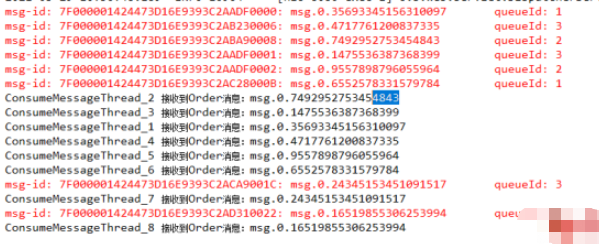 Java
Java
 javaTutorial
javaTutorial
 How SpringBoot integrates RocketMQ transactions, broadcasts and sequential messages
How SpringBoot integrates RocketMQ transactions, broadcasts and sequential messages
How SpringBoot integrates RocketMQ transactions, broadcasts and sequential messages
May 18, 2023 am 10:04 AMEnvironment: springboot2.3.9RELEASE RocketMQ4.8.0
Dependency
<dependency>???<groupid>org.springframework.boot</groupid>?????<artifactid>spring-boot-starter-web</artifactid>?</dependency>?<dependency>?????<groupid>org.apache.rocketmq</groupid>?????<artifactid>rocketmq-spring-boot-starter</artifactid>?????<version>2.2.0</version>?</dependency>
Configuration file
server:???port:?8080?---?rocketmq:???nameServer:?localhost:9876???producer:?????group:?demo-mq
Normal message
Send
@Resource?private?RocketMQTemplate?rocketMQTemplate?;??????public?void?send(String?message)?{???rocketMQTemplate.convertAndSend("test-topic:tag2",?MessageBuilder.withPayload(message).build());?}
Accept
@RocketMQMessageListener(topic?=?"test-topic",?consumerGroup?=?"consumer01-group",?selectorExpression?=?"tag1?||?tag2")?@Component?public?class?ConsumerListener?implements?RocketMQListener<string>?{??????@Override?????public?void?onMessage(String?message)?{?????????System.out.println("接收到消息:"?+?message)?;?????}??}</string>
Sequential messages
Send
@Resource?private?RocketMQTemplate?rocketMQTemplate?;??public?void?sendOrder(String?topic,?String?message,?String?tags,?int?id)?{?????rocketMQTemplate.asyncSendOrderly(topic?+?":"?+?tags,?MessageBuilder.withPayload(message).build(),??????????????"order-"?+?id,?new?SendCallback()?{?????????????????@Override?????????????????public?void?onSuccess(SendResult?sendResult)?{?????????????????????System.err.println("msg-id:?"?+?sendResult.getMsgId()?+?":?"?+?message?+"\tqueueId:?"?+?sendResult.getMessageQueue().getQueueId())?;?????????????????}?????????????????@Override?????????????????public?void?onException(Throwable?e)?{?????????????????????e.printStackTrace()?;?????????????????}?????????????});?}
Here are messages sent to different queues based on hashkey
@RocketMQMessageListener(topic?=?"order-topic",?consumerGroup?=?"consumer02-group",??????selectorExpression?=?"tag3?||?tag4",?consumeMode?=?ConsumeMode.ORDERLY)?@Component?public?class?ConsumerOrderListener?implements?RocketMQListener<string>?{??????@Override?????public?void?onMessage(String?message)?{?????????System.out.println(Thread.currentThread().getName()?+?"?接收到Order消息:"?+?message)?;?????}??}</string>
consumeMode = ConsumeMode.ORDERLY, Indicates that the message mode is sequential mode, one queue and one thread.
Result

When consumeMode = ConsumeMode.CONCURRENTLY, the execution result is as follows:

Cluster/Broadcast Message mode
Sender
@Resource?private?RocketMQTemplate?rocketMQTemplate?;??????public?void?send(String?topic,?String?message,?String?tags)?{?????rocketMQTemplate.send(topic?+?":"?+?tags,?MessageBuilder.withPayload(message).build())?;?}
Cluster message mode
Consumer
@RocketMQMessageListener(topic?=?"broad-topic",?consumerGroup?=?"consumer03-group",??????selectorExpression?=?"tag6?||?tag7",?messageModel?=?MessageModel.CLUSTERING)?@Component?public?class?ConsumerBroadListener?implements?RocketMQListener<string>?{??????@Override?????public?void?onMessage(String?message)?{?????????System.out.println("ConsumerBroadListener1接收到消息:"?+?message)?;?????}??}</string>
messageModel = MessageModel.CLUSTERING
Test
Start two services with ports 8080 and 8081
8080 service

8081 service

In the cluster message mode, each service receives a part of the message separately to achieve load balancing
Broadcast message mode
Consumer end
@RocketMQMessageListener(topic?=?"broad-topic",?consumerGroup?=?"consumer03-group",??????selectorExpression?=?"tag6?||?tag7",?messageModel?=?MessageModel.BROADCASTING)?@Component?public?class?ConsumerBroadListener?implements?RocketMQListener<string>?{??????@Override?????public?void?onMessage(String?message)?{?????????System.out.println("ConsumerBroadListener1接收到消息:"?+?message)?;?????}??}</string>
messageModel = MessageModel.BROADCASTING
Test
Start two services with ports 8080 and 8081
8080 service

8081 service

In cluster message mode, each service receives the same message.
Transaction message
The 3 statuses of RocketMQ transactions
TransactionStatus.CommitTransaction: Submit transaction message, consumers can consume this message
TransactionStatus.RollbackTransaction: Rolling back the transaction means that the message will be deleted and not allowed to be consumed.
TransactionStatus.Unknown: Intermediate status, which represents the need to check the message queue to determine the status.
RocketMQ's implementation of transaction messages is mainly divided into two stages: normal transaction sending and submission, and transaction information compensation process. The overall process is:
Normal transaction sending and submission stage
1. The producer sends a half message to MQServer (a half message refers to a message that the consumer cannot consume temporarily)
2. The server responds to the message writing result and the half message is sent successfully
3. Start executing the local transaction
4. Perform the Commit or Rollback operation according to the execution status of the local transaction
Compensation process of transaction information
1. If MQServer does not receive it for a long time The execution status of the local transaction will initiate a confirmation review operation request to the producer
2. After the producer receives the confirmation review request, it checks the execution status of the local transaction
3. According to After checking the results, execute the Commit or Rollback operation.
The compensation phase is mainly used to solve the problem of timeout or failure when the producer sends the Commit or Rollback operation.
Sender
@Resource?private?RocketMQTemplate?rocketMQTemplate?;??????public?void?sendTx(String?topic,?Long?id,?String?tags)?{?????rocketMQTemplate.sendMessageInTransaction(topic?+?":"?+?tags,?MessageBuilder.withPayload(?????????????new?Users(id,?UUID.randomUUID().toString().replaceAll("-",?""))).?????????????setHeader("BID",?UUID.randomUUID().toString().replaceAll("-",?"")).build(),??????????????UUID.randomUUID().toString().replaceAll("-",?""))?;?}
The listener corresponding to the producer
@RocketMQTransactionListener?public?class?ProducerTxListener?implements?RocketMQLocalTransactionListener?{??????????@Resource?????private?BusinessService?bs?;??????@Override?????public?RocketMQLocalTransactionState?executeLocalTransaction(Message?msg,?Object?arg)?{?????????//?這里執(zhí)行本地的事務(wù)操作,比如保存數(shù)據(jù)。?????????try?{?????????????//?創(chuàng)建一個(gè)日志記錄表,將這唯一的ID存入數(shù)據(jù)庫(kù)中,在下面的check方法中可以根據(jù)這個(gè)id查詢(xún)是否有數(shù)據(jù)?????????????String?id?=?(String)?msg.getHeaders().get("BID")?;?????????????Users?users?=?new?JsonMapper().readValue((byte[])msg.getPayload(),?Users.class)?;?????????????System.out.println("消息內(nèi)容:"?+?users?+?"\t參與數(shù)據(jù):"?+?arg?+?"\t本次事務(wù)的唯一編號(hào):"?+?id)?;?????????????bs.save(users,?new?UsersLog(users.getId(),?id))?;?????????}?catch?(Exception?e)?{?????????????e.printStackTrace()?;?????????????return?RocketMQLocalTransactionState.ROLLBACK?;?????????}?????????return?RocketMQLocalTransactionState.COMMIT?;?????}??????@Override?????public?RocketMQLocalTransactionState?checkLocalTransaction(Message?msg)?{?????????//?這里檢查本地事務(wù)是否執(zhí)行成功?????????String?id?=?(String)?msg.getHeaders().get("BID")?;?????????System.out.println("執(zhí)行查詢(xún)ID為:"?+?id?+?"?的數(shù)據(jù)是否存在")?;?????????UsersLog?usersLog?=?bs.queryUsersLog(id)?;?????????if?(usersLog?==?null)?{?????????????return?RocketMQLocalTransactionState.ROLLBACK?;?????????}?????????return?RocketMQLocalTransactionState.COMMIT?;?????}??}
Consumer
@RocketMQMessageListener(topic?=?"tx-topic",?consumerGroup?=?"consumer05-group",?selectorExpression?=?"tag10")?@Component?public?class?ConsumerTxListener?implements?RocketMQListener<users>?{??????@Override?????public?void?onMessage(Users?users)?{?????????System.out.println("TX接收到消息:"?+?users)?;?????}??}</users>
Service
@Transactional?public?boolean?save(Users?users,?UsersLog?usersLog)?{?????usersRepository.save(users)?;?????usersLogRepository.save(usersLog)?;?????if?(users.getId()?==?1)?{?????????throw?new?RuntimeException("數(shù)據(jù)錯(cuò)誤")?;?????}?????return?true?;?}??????public?UsersLog?queryUsersLog(String?bid)?{?????return?usersLogRepository.findByBid(bid)?;?}
Controller
@GetMapping("/tx/{id}")?public?Object?sendTx(@PathVariable("id")Long?id)?{?????ps.sendTx("tx-topic",?id,?"tag10")?;?????return?"send?transaction?success"?;?} Test
After calling the interface, the console output:

It can be seen from the print log that the consumer receives the message only after all the messages have been saved.


Deleting the data and then testing the ID as 1 will result in an error.

There is no data in the database. . .
Isn’t it very complicated? It can be handled in 2 stages.
The above is the detailed content of How SpringBoot integrates RocketMQ transactions, broadcasts and sequential messages. For more information, please follow other related articles on the PHP Chinese website!

Hot AI Tools

Undress AI Tool
Undress images for free

Undresser.AI Undress
AI-powered app for creating realistic nude photos

AI Clothes Remover
Online AI tool for removing clothes from photos.

Clothoff.io
AI clothes remover

Video Face Swap
Swap faces in any video effortlessly with our completely free AI face swap tool!

Hot Article

Hot Tools

Notepad++7.3.1
Easy-to-use and free code editor

SublimeText3 Chinese version
Chinese version, very easy to use

Zend Studio 13.0.1
Powerful PHP integrated development environment

Dreamweaver CS6
Visual web development tools

SublimeText3 Mac version
God-level code editing software (SublimeText3)

Hot Topics
 How Springboot integrates Jasypt to implement configuration file encryption
Jun 01, 2023 am 08:55 AM
How Springboot integrates Jasypt to implement configuration file encryption
Jun 01, 2023 am 08:55 AM
Introduction to Jasypt Jasypt is a java library that allows a developer to add basic encryption functionality to his/her project with minimal effort and does not require a deep understanding of how encryption works. High security for one-way and two-way encryption. , standards-based encryption technology. Encrypt passwords, text, numbers, binaries... Suitable for integration into Spring-based applications, open API, for use with any JCE provider... Add the following dependency: com.github.ulisesbocchiojasypt-spring-boot-starter2. 1.1Jasypt benefits protect our system security. Even if the code is leaked, the data source can be guaranteed.
 How to use Redis to implement distributed locks in SpringBoot
Jun 03, 2023 am 08:16 AM
How to use Redis to implement distributed locks in SpringBoot
Jun 03, 2023 am 08:16 AM
1. Redis implements distributed lock principle and why distributed locks are needed. Before talking about distributed locks, it is necessary to explain why distributed locks are needed. The opposite of distributed locks is stand-alone locks. When we write multi-threaded programs, we avoid data problems caused by operating a shared variable at the same time. We usually use a lock to mutually exclude the shared variables to ensure the correctness of the shared variables. Its scope of use is in the same process. If there are multiple processes that need to operate a shared resource at the same time, how can they be mutually exclusive? Today's business applications are usually microservice architecture, which also means that one application will deploy multiple processes. If multiple processes need to modify the same row of records in MySQL, in order to avoid dirty data caused by out-of-order operations, distribution needs to be introduced at this time. The style is locked. Want to achieve points
 How SpringBoot customizes Redis to implement cache serialization
Jun 03, 2023 am 11:32 AM
How SpringBoot customizes Redis to implement cache serialization
Jun 03, 2023 am 11:32 AM
1. Customize RedisTemplate1.1, RedisAPI default serialization mechanism. The API-based Redis cache implementation uses the RedisTemplate template for data caching operations. Here, open the RedisTemplate class and view the source code information of the class. publicclassRedisTemplateextendsRedisAccessorimplementsRedisOperations, BeanClassLoaderAware{//Declare key, Various serialization methods of value, the initial value is empty @NullableprivateRedisSe
 How to solve the problem that springboot cannot access the file after reading it into a jar package
Jun 03, 2023 pm 04:38 PM
How to solve the problem that springboot cannot access the file after reading it into a jar package
Jun 03, 2023 pm 04:38 PM
Springboot reads the file, but cannot access the latest development after packaging it into a jar package. There is a situation where springboot cannot read the file after packaging it into a jar package. The reason is that after packaging, the virtual path of the file is invalid and can only be accessed through the stream. Read. The file is under resources publicvoidtest(){Listnames=newArrayList();InputStreamReaderread=null;try{ClassPathResourceresource=newClassPathResource("name.txt");Input
 How SpringBoot integrates Redisson to implement delay queue
May 30, 2023 pm 02:40 PM
How SpringBoot integrates Redisson to implement delay queue
May 30, 2023 pm 02:40 PM
Usage scenario 1. The order was placed successfully but the payment was not made within 30 minutes. The payment timed out and the order was automatically canceled. 2. The order was signed and no evaluation was conducted for 7 days after signing. If the order times out and is not evaluated, the system defaults to a positive rating. 3. The order is placed successfully. If the merchant does not receive the order for 5 minutes, the order is cancelled. 4. The delivery times out, and push SMS reminder... For scenarios with long delays and low real-time performance, we can Use task scheduling to perform regular polling processing. For example: xxl-job Today we will pick
 How to implement Springboot+Mybatis-plus without using SQL statements to add multiple tables
Jun 02, 2023 am 11:07 AM
How to implement Springboot+Mybatis-plus without using SQL statements to add multiple tables
Jun 02, 2023 am 11:07 AM
When Springboot+Mybatis-plus does not use SQL statements to perform multi-table adding operations, the problems I encountered are decomposed by simulating thinking in the test environment: Create a BrandDTO object with parameters to simulate passing parameters to the background. We all know that it is extremely difficult to perform multi-table operations in Mybatis-plus. If you do not use tools such as Mybatis-plus-join, you can only configure the corresponding Mapper.xml file and configure The smelly and long ResultMap, and then write the corresponding sql statement. Although this method seems cumbersome, it is highly flexible and allows us to
 Comparison and difference analysis between SpringBoot and SpringMVC
Dec 29, 2023 am 11:02 AM
Comparison and difference analysis between SpringBoot and SpringMVC
Dec 29, 2023 am 11:02 AM
SpringBoot and SpringMVC are both commonly used frameworks in Java development, but there are some obvious differences between them. This article will explore the features and uses of these two frameworks and compare their differences. First, let's learn about SpringBoot. SpringBoot was developed by the Pivotal team to simplify the creation and deployment of applications based on the Spring framework. It provides a fast, lightweight way to build stand-alone, executable
 How to use the @Import annotation in SpringBoot
May 31, 2023 pm 06:25 PM
How to use the @Import annotation in SpringBoot
May 31, 2023 pm 06:25 PM
1. @Import introduces ordinary classes @Import introduces ordinary classes can help us define ordinary classes as Beans. @Import can be added to the classes corresponding to @SpringBootApplication (startup class), @Configuration (configuration class), and @Component (component class). Note: @RestController, @Service, and @Repository all belong to @Component@SpringBootApplication@Import(ImportBean.class)//ImportBean through the @Import annotation





